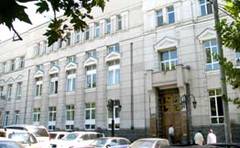
 By Emil Danielyan
By Emil Danielyan
Photo: Central Bank of Armenia
Armenia?s economy is emerging from its first major downturn since the early 1990?s faster than expected, helped by similar recovery globally. Official statistics show that it expanded by 6.7 percent in the first half of this year and surpassed even the most optimistic government expectations. The Armenian authorities now expect full-year growth to reach between 5 to 7 percent, sharply up from the 1.2 percent forecast last December.
Armenia was one of the countries hardest hit by the global recession: GDP contracted by as much as 14.4 percent last year after a decade of robust growth. A slump in construction, international prices of base metals (the country?s main export item) and multimillion-dollar remittances from Armenians working abroad was instrumental in the GDP decline. It would have been even sharper without the large-scale anti-crisis loans obtained by Yerevan from Moscow, the International Monetary Fund (IMF), World Bank and other international lending institutions.
Year-on-year negative growth stopped and even moved into positive territory in the fourth quarter of 2009. It progressively accelerated from 2.2 percent in January 2010 to 8.8 percent in January-May. The growth rate slowed in June because of a sharp fall in agricultural production resulting from highly unfavorable weather conditions. It was more than offset by a 12.3 percent rise in industrial output, the main driving force behind the first-half year growth, which has benefited from rallying international prices of copper, molybdenum and other base metals. Other export-oriented manufacturing sectors of the economy, notably food and diamond processing, also reported strong production increases. That translated into a 56 percent surge in Armenian exports totaling $443 million in the six-month period. The National Statistical Service (NSS) registered more modest gains in construction and services other than the retail trade (The National Statistical Service, www.armstat.am).
Another factor behind the recovery is renewed growth in cash transfers from Armenian migrant workers abroad. According to the Armenian Central Bank, the total amount of non-commercial remittances, most of them coming from Russia, rose by over 10 percent to $380 million in January-May: equivalent to 14.4 percent of GDP. The improved macroeconomic performance led the Armenian government to declare an end to the economic crisis, which is estimated to have pushed up the country?s official poverty rate from over 25 percent to about 29 percent. ?We have entered a renewed phase of stable economic development,? Finance Minister, Tigran Davtian, told journalists (Arminfo, July 4). Opposition politicians dismissed these assurances, again questioning the credibility of the government?s macroeconomic data. ?The economy remains in serious crisis,? insisted Hrant Bagratian, a former Prime Minister now affiliated with the main opposition Armenian National Congress (www.armenialiberty.org, July 20).
Nevertheless, the IMF, which trusts the official figures, essentially shared the government?s assessment of the improving economic situation. ?The Armenian economy is emerging from a deep downturn,? the fund?s deputy managing director, Murilo Portugal, said in a June 28 statement (www.imf.org) that announced the release of a new IMF loan package for Armenia worth $395 million.
The fund cut short the $830 million lending program, which it had launched in March 2009 to help the authorities in Yerevan cope with the recession. They have since received $560 million worth of loans under that scheme. Portugal explained that Armenia?s ongoing economic recovery is necessitating a change in the authorities? economic priorities and that the new program will enable them to renew their focus on ?medium-term challenges.? Achieving ?strong growth? is one of those challenges, he said.
Visiting Yerevan in May, Mark Lewis, another senior IMF official, warned that Armenian growth will continue to be hampered by poor and arbitrary tax collection and ?powerful oligopolies,? which he said play an important role in the domestic economy. He repeated IMF arguments that the amount of taxes collected by the Armenian government is ?very low by international standards,? in both absolute and relative terms (ARKA, May 19).
The subsequent IMF statement, quoting Portugal, said the government has drawn up a ?broad tax administration reform? program and pledged to implement other ?wide-ranging structural reforms? that would improve Armenia?s flawed business environment. The country?s technocrat Prime Minister, Tigran Sargsyan, has repeatedly (and vocally) described such reforms as a top priority. However, his reform record has been patchy so far, with many Armenian government-linked businessmen continuing to enjoy privileged treatment by tax authorities and the under reporting of their earnings. Some of them have also effectively monopolized lucrative forms of business, such as fuel and food imports.
The government?s first-half year tax revenues soared by 23 percent to 286.2 billion drams ($785 million), bringing the state budget down to a level equivalent to 1.3 percent of GDP. Data from the Armenian finance ministry indicates that increased proceeds from value-added tax generated much of this increase, whereas government revenues from corporate profit tax shrunk by more than 3 percent (www.armenialiberty.org, August 3). This is a clear indication that tax evasion among Armenian companies remains widespread.
However, the tax revenue total was almost 12 percent higher than the government had projected for the first half of 2010. The government further highlighted its improving fiscal position in early July, when it restored the practice of drawing up three-year budgetary expenditure plans, which were suspended in 2009 because of the economic crisis. The government?s spending targets for the next three years are based on the expectation that the Armenian economy will continue to grow in 2011-2013 at an average annual rate of roughly 4 percent.
Source: The Jamestown Foundation, 11 August 2010
Publication: Eurasia Daily Monitor Volume: 7 Issue: 155 (URL)
